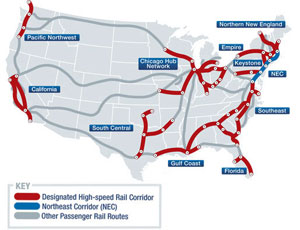High-speed rail advocates celebrated the Jan. 28 award of grants from the $8-billion pot that is part of the American Recovery and Reinvestment Act, but officials must now figure out how to leverage the seed money into successful long-term programs. California and Florida, the anticipated big grant winners at $2.25 billion and $1.25 billion, respectively, are now pondering design-build and public-private partnerships along with other funding sources.
The U.S. Dept. of Transportation was flooded with applications, receiving $57 billion in project funding proposals. That total includes $50 billion in rail-corridor proposals submitted by 24 states and $7 billion from 34 states for specific projects.
Most of the funds went to long-term programs that now can proceed with environmental reviews and preliminary engineering. But some projects specifically were “shovel-ready,” says David J. Carol, market leader of high-speed rail for Parsons Brinckerhoff, New York City. “Those will be going to design-build or final design fairly quickly under the terms of the legislation, in which they need to be completed in two years,” he says. “A year out, you’ll see some heavy-duty construction.”
Florida’s Tampa-Orlando line could be the first to debut, since the state Dept. of Transportation (FDOT) had already allotted it room in the median of Interstate 4. Right-of-way procurements are almost complete, but additional funding is still a concern, officials say.
“We are very excited by what the Federal Railroad Administration is awarding us, but we will have to look at this and figure out a plan to facilitate the system,” says Nazih Haddad, FDOT manager for passenger-rail development. “We don’t have answers about the rest of the funding at this time. We will look at the situation and decide. It’s important to note that the agency is providing dollars only as a down payment. There may be additional funding at a later date.”
Even so, high-speed-rail advocates are encouraged by the unprecedented investment in high-speed rail. “I’m relieved and happy,” says Peter Gertler, HNTB director of high-speed rail and a newly named senior vice president. “It’s like the day after a big party.”
But some constructors are skeptical. “I’m not sure anybody knows what they’re going to do now,” says Robert G. Burleson, president of the Florida Transportation Builders Association, Tallahassee. “I don’t think anybody knows exactly what the parameters are with the money. It’s pretty obvious you can’t build a train from Orlando to Tampa with just $1.25 billion,” he says. “Quite honestly, there isn’t $1.25 billion of transportation money to commit over the next five years to high-speed rail, even if the [federal government] wanted to, unless [it] totally shuts down the highway program. We’re in a real dilemma.”
Rick Chesser, regional director for Reynolds Smith & Hills, Jacksonville, Fla., says the construction community is in a “wait-and-see mode” to see how the projects progress. He notes that at a DOT forum in December, there were discussions about the Tampa-Orlando leg, “what [officials] called the civil works to prepare the track bed to accept the track and electrification,” he says, noting officials at the event said the second phase “would be to bring in track electrification and equipment and then to operate and maintain the system.”
International firms boasting previous high-speed rail experience are eager to get onboard with American partners. “It comes at the right time, and I think we have the elements in place to be one of the serious competitors for this work, in whatever fashion it comes out,” says Lauro Bravar, chief operating officer for OHL USA, the Miami-based...



Post a comment to this article
Report Abusive Comment